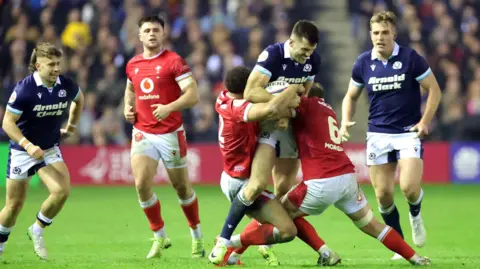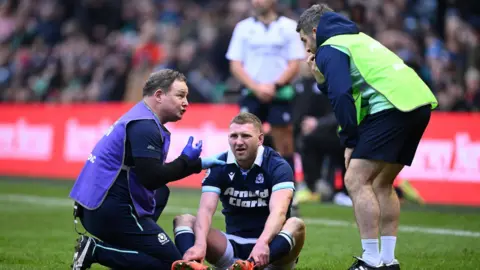Rugby tackle change linked to drop in head collisions
 PA Media
PA MediaLowering the tackle height in men's rugby almost halved the rate of head collisions among players, a study at Edinburgh University has found.
The lowered tackle height law was introduced for community rugby by World Rugby in the 2023/24 season in an attempt to improve safety for players.
Researchers at Edinburgh University used video analysis to study tackles from 60 men's community matches in Scotland before the trial and during it, and found the law change resulted in a 45% reduction in head-on-head contact.
Experts previously found head-to-head contact was one of the primary causes of sports related concussion.
Both rugby union and rugby league authorities are facing ongoing legal action from former players who have suffered brain injuries.
The study - which examined 18,702 tackles - also linked the law change to a 29% reduction in head-to-shoulder contact for the tackler and ball-carrier.
During the trial period in the 2023/24 season players were 22% more likely to tackle bent at the waist, the recommended technique to reduce player head proximity and contact.
 Getty Images
Getty ImagesDr Debbie Palmer, of the Institute for Sport, Physical Education and Health Sciences at the Moray House School of Education and Sport, and co-director for the UK Collaborating Centre on Injury and Illness Prevention in Sport IOC Research Centre, has been involved in researching concussions in rugby for about 10 years.
She told BBC Scotland News: "We know concussion is amongst the most common injury, but we also know participation in sport, particularly at recreational level, is really beneficial. We want to reduce the risks of injury and keep people involved in sport.
"We don't have injury data within the men's level to say if it has had an impact on concussion rates, but we do know approximately 250 head contacts for the tackler and just over 300 head contacts for the ball carrier potentially have been saved for one season."
Dr Palmer said the findings were "very encouraging" but it remained to be seen if the law changes were applied at the professional game as well as at community level.
She added: "The risks of injury, the risks of concussion, and the mechanisms for those types of injury do differ between professional players and amateur players, but this is a decision that Scottish Rugby and World Rugby will be looking at, and making, in the coming months."
The study's lead author, Hamish Gornall - of Edinburgh University's Moray House School of Education and Sport - added the study showed the rule change - which lowered the height from the shoulder to below the sternum or breastbone - had proved "effective" in altering tackling behaviour.
Mr Gornall told BBC Scotland News the increase in so-called "belly tackles" was promising.
He said: "The really encouraging highlight points are players are bending at the waist more often, we're seeing less contact at the high risk areas and that's resulted in less head to head and head to shoulder contacts. It's a really positive outcome from the study."

Edinburgh flanker Magnus Bradbury told BBC Scotland News applying the new law to the professional game could prove difficult.
"It's a lot easier at the lower leagues because you're not playing against people like Gilco [Edinburgh lock Grant Gilchrist] or Pierre Schoeman, who are 130 kilos and running right at you where you've got a split second to make a decision," he said.
"But in a perfect world, I'd love to have a game where you're not getting hit in the head. At the moment we'll just have to see what happens."
His teammate Darcy Graham - who suffered a head injury during the Six Nations defeat against Ireland in February - added that he felt the professional game was " "pretty safe" as it was, but any steps to improve safety would be welcome.
Edinburgh head coach Steve Everitt said: "We want the game to be safe, we want children to be able to play it and parents be able to support them with comfort, knowing they are protected.
"At the same time, we've got to be be careful because it is a contact sport. Bringing it into pro rugby would be an interesting call because it could make the game faster and change the way you defend."
World Rugby trial
The study is part of an international project led by World Rugby to assess the effects of lowering the tackle height in a host of countries, including France, New Zealand and Australia.
Researchers found no significant increase in tacklers' heads coming into contact with the ball-carriers' hips or knees, which is associated with an increased risk of head injury assessments and concussion diagnosis.
The trial was adopted by Scottish Rugby and made compulsory across all amateur playing levels.
Scottish Rugby chief medical officer Dr David Pugh said: "At Scottish Rugby we strive to reduce the incidence of concussion in as many ways as we can.
"We are also working with the university on an injury surveillance project, and we hope that this will see a significant drop in concussion rates due to the lower tackle height trial.
"Hamish's research clearly demonstrates that player behaviours have changed, reducing head-to-head and head-to-shoulder contacts which should lead to reduced numbers of concussions in our players."
In 2023 a study of former rugby players brains by Glasgow University found that out of 31 donated brains analysed, 21 had evidence of a condition linked to repeated head injuries and concussion.
A Durham University study last year suggested rugby players who have suffered multiple concussions have biological differences that may make them more prone to developing motor neurone disease (MND) - the condition that former Scottish internationalist Doddie Weir died from.
More than 1,000 former amateur and professional rugby union and rugby league players are currently involved in a long-running concussion lawsuit against the sports' governing bodies.
